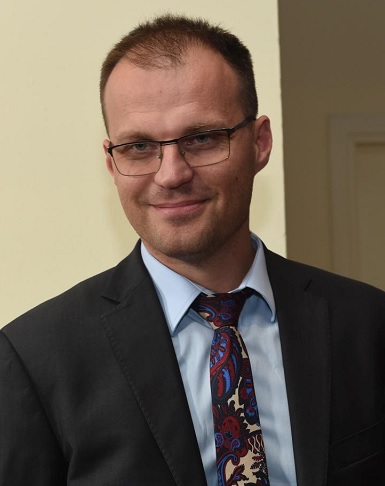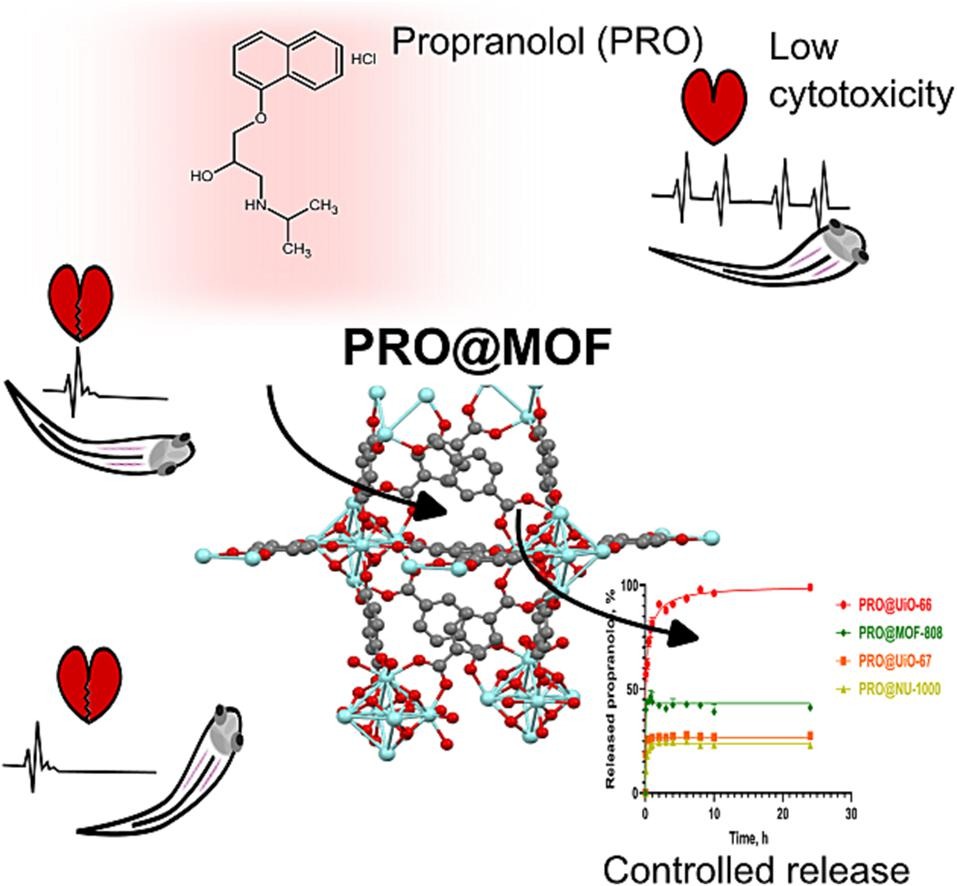A new safe and effective method of removing drugs from the body has been discovered by scientists at the Cracow University of Technology in collaboration with researchers from other Polish research centres - from Cracow and Lublin. They propose the use of Metal-Organic Frameworks (MOFs) as carriers for drugs from the group of so-called β-blockers, used to detoxify the body from narcotic substances. The effects of their work on an innovative method of propranolol administration in mephedrone overdose were described by a research team led by Prof. Przemysław Jodłowski from the Cracow University of Technology in the prestigious "Chemical Engineering Journal" (IF 15.1).
 Drug addiction has become a dangerous disease of the 21st century, and it affects young people in particular. Mephedrone is a particularly dangerous intoxicant. The compound, included in the group of synthetic cathinones, imitates amphetamine in its structure and effect. Although it was outlawed in 2010, it remains popular in the illicit trade due to its relatively low price and easy availability on the black market. Its overdose, however, can lead to severe health and even life-threatening risks.
Drug addiction has become a dangerous disease of the 21st century, and it affects young people in particular. Mephedrone is a particularly dangerous intoxicant. The compound, included in the group of synthetic cathinones, imitates amphetamine in its structure and effect. Although it was outlawed in 2010, it remains popular in the illicit trade due to its relatively low price and easy availability on the black market. Its overdose, however, can lead to severe health and even life-threatening risks.
How can a patient with overdose symptoms of this drug be saved? One solution offered to medicine here is based on observing the symptoms caused by the use of mephedrone, such as an increase in blood pressure. The standard treatment for hypertensive patients is medication from the so-called β-blocker group, which acts as β-adrenergic receptor antagonists, causing a reduction in blood pressure and heart rate. Drugs from the same group, e.g. propranolol, commonly used for cardiac arrhythmias, can also be used for detoxification after drug intoxication. – The problem to be solved in the context of the use of drugs from the β-blocker group in mephedrone intoxication was to find a suitable carrier that would release the drug safely and effectively – that is, gradually and directionally, while excluding the effect of the first passage of the drug. This effect results in the elimination of the drug from the body (by metabolic processes taking place, for example, in the intestinal mucosa and liver) before getting into the systemic circulation – says dr hab. inż. Przemysław Jodłowski, Prof. of CUT from the Faculty of Chemical Engineering and Technology of the Cracow University of Technology.
Under his supervision, an interdisciplinary team of researchers (from the Cracow University of Technology, the Jagiellonian University, the AGH University of Krakow, the Medical University of Lublin and the Institute of Rock Mass Mechanics of the Polish Academy of Sciences) developed an effective and innovative detoxification system for the body, solving these problems. They conducted the research as part of a project entitled 'Modern materials based on metal-organic networks for the removal of psychoactive substances - synthesis, chemical characterisation, toxicity and efficiency for in vitro and in vivo studies', funded by the National Science Centre in the OPUS 22 competition.
– Current detoxification methods mainly involve cleansing the body by gradually flushing toxins out of the body using intravenously administered agents. However, it should be remembered that the rapid removal of drugs can lead to strong reactions in the body, which may be manifested, for example, by cardiac arrhythmia or epileptic seizures. Our idea is to use metal-organic networks to remove drugs from the body. Thanks to their characteristics, a sudden reaction of the body to the administration of the antidote can be avoided – explains dr hab. inż. Przemysław Jodłowski, Prof. of CUT. – The use of metal-organic networks – thanks to the possibility of their modification – allows for controlled drug adsorption and controlled administration of the antidote for poisoning the organism.
 MOFs, or metal-organic networks, are substances having a one-dimensional, two-dimensional or three-dimensional structure, depending on the materials used in their construction. They consist of metal ions that are joined together by organic ligands to form a crystalline structure. These materials have applications in many fields, from medicine (drug delivery, tomographic imaging) to catalysis, labelling or gas adsorption. The innovative approach, proposed by the team led by Prof. Przemysław Jodłowski, takes the science of metal-organic networks to a new, higher level and opens up many potential medical applications. The extensive competences and scientific capabilities of researchers from Prof. Jodłowski's team allowed for an accurate characterisation of the materials, extended with theoretical calculations and, above all, biological research. The results of the research confirmed that the organometallic skeleton can be used as a carrier of the drug eliminating the effects of mephedrone abuse and as an adsorbent of this drug.
MOFs, or metal-organic networks, are substances having a one-dimensional, two-dimensional or three-dimensional structure, depending on the materials used in their construction. They consist of metal ions that are joined together by organic ligands to form a crystalline structure. These materials have applications in many fields, from medicine (drug delivery, tomographic imaging) to catalysis, labelling or gas adsorption. The innovative approach, proposed by the team led by Prof. Przemysław Jodłowski, takes the science of metal-organic networks to a new, higher level and opens up many potential medical applications. The extensive competences and scientific capabilities of researchers from Prof. Jodłowski's team allowed for an accurate characterisation of the materials, extended with theoretical calculations and, above all, biological research. The results of the research confirmed that the organometallic skeleton can be used as a carrier of the drug eliminating the effects of mephedrone abuse and as an adsorbent of this drug.
An article on the innovative Polish research entitled "Metal-organic frameworks for efficient mephedrone detoxification or supervised withdrawal – synthesis, characterisation and in vivo studies" was published in the prestigious Chemical Engineering Journal. Dr hab. inż. Przemysław Jodłowski, Prof. of CUT, the head of the project financed by the National Science Centre, emphasises that the research carried out within its framework is possible thanks to the involvement of experts from various fields from several prestigious scientific institutions. The project – apart from the Faculty of Chemical Engineering and Technology of the Cracow University of Technology – involves the Medical University of Lublin, the Institute of Rock Mass Mechanics of the Polish Academy of Sciences, the Faculty of Chemistry of the Jagiellonian University and the Faculty of Materials Engineering and Ceramics of the AGH University of Krakow. The members of the team are: dr hab. inż. Przemysław Jodłowski, Prof. of CUT, dr inż. Grzegorz Kurowski, mgr inż. Klaudia Dymek, mgr inż. Kornelia Hyjek, dr inż. Paweł Śliwa – all from the Cracow University of Technology, as well as dr hab. Barbara Budzyńska, Prof. of the MUL, Anna Boguszewska-Czubara, M.D., Prof. of MUL, dr Olga Wronikowska-Denysiuk – Medical University of Lublin, prof. dr hab. Witold Piskorz from the Faculty of Chemistry of the Jagiellonian University, prof. dr hab. inż. Maciej Sitarz, dr hab. inż. Magdalena Szumera, Prof. of AGH, dr inż. Piotr Jeleń (Faculty of Materials Engineering and Ceramics at the AGH University of Krakow), mgr inż. Aleksandra Gajda (Institute of Rock Mass Mechanics of the Polish Academy of Sciences).
Researchers from CUT and collaborating experts from other centres will develop their innovative method and go through various stages to implement it in medicine. They hope to finalise it into a medication (in the form of an easy-to-use powder) that will help fight one of the pressing problems of the modern age.
(bk, mas, pj)
In the photo, dr hab. inż. Przemysław Jodłowski, Prof. of CUT / photo Jan Zych
Graphics from the article entitled "Metal-organic frameworks for efficient mephedrone detoxification or supervised withdrawal – synthesis, characterisation and in vivo studies", published in the Chemical Engineering Journal



